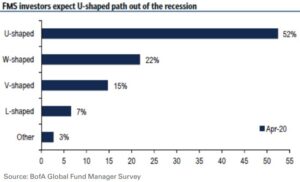Last week’s letter explored possible green shoots as market drivers. There are good reasons to focus on the green shoots. First, the recession was a result of a medically induced voluntary shut down, not an exhausted economy. Therefore, a “voluntary” recovery could be at hand as workers stand ready to meet consumers’ spending desires. Secondarily, the swift government monetary backstops and fiscal lifelines were extraordinary in their depth, breadth and international coordination.
Focus on an eventual recovery alone can’t account for the spectacular rebound since the market low point on March 23rd. Last week the technology heavy NASDAQ Index turned positive for the year! Even the very early green shoots can’t fully explain such a dramatic snap back. It seems the answer may lay within ourselves.
Behavioral finance is the intersection of psychology and finance. In other words, the study of how individuals make financial decisions. Behavioral finance has been around for over 20 years with more prominence since the ’08-’09 Credit Crisis. Behavioral finance has identified numerous aspects of how our emotional being usurps logical thinking. This often explains why markets seem irrational in the short term, yet logical in the long term. This is also why capital market research tends to focus on the longer-term.
Investors’ fear of missing out (FOMO) may be contributing to market valuations exceeding near-term fundamentals. Ultimately, markets can’t escape fundamentals. High valuations can be resolved by stock prices declining to meet fundamentals or stabilizing to let fundamentals catch up to valuations. Rarely is near-term market timing a fruitful exercise as market direction and duration are unknown.
Looking to the longer term, we’re likely to see greater variation in the equity market performance of different stocks and sectors as the economy moves through the various stages of recovery. Equity markets may be entering a period of higher variability, contrary to the past decade. Investors should be prepared for markets, sectors and asset classes to move up and down as levels of economy and health uncertainty remain high. Going forward, portfolio diversification may be as important as ever.

CRN-3084600-051320


Recent Comments